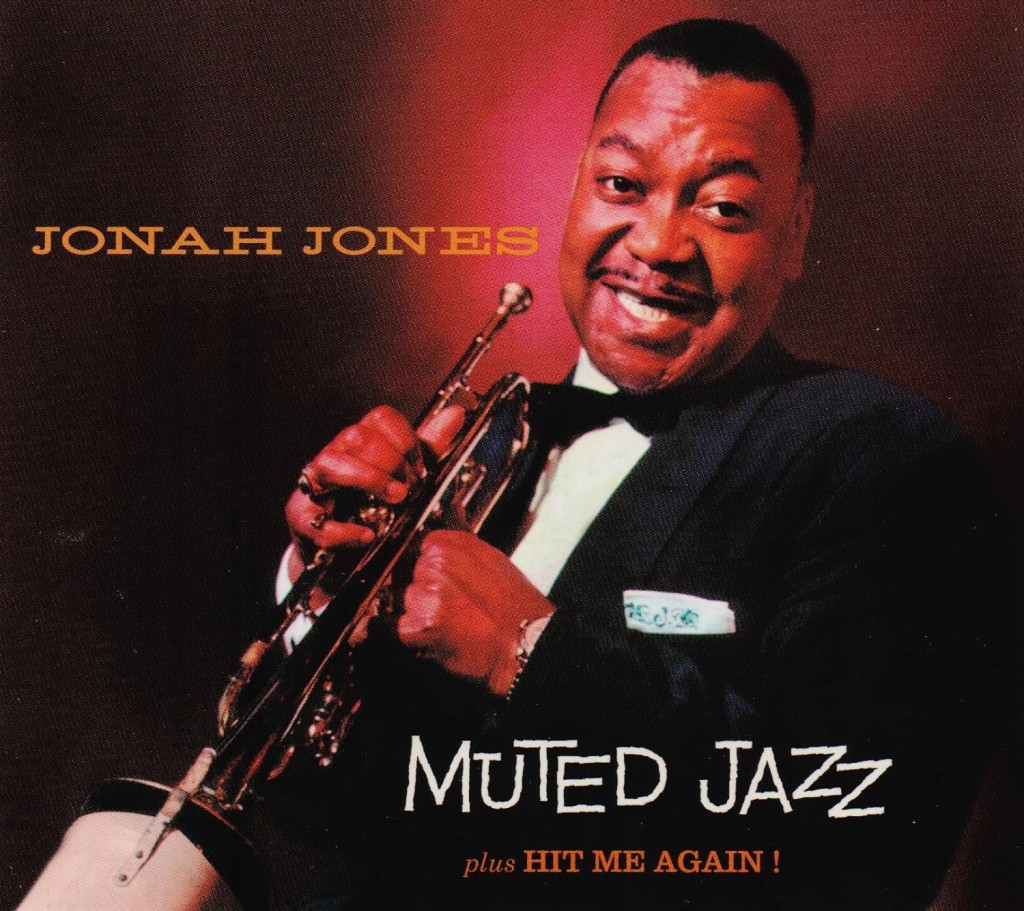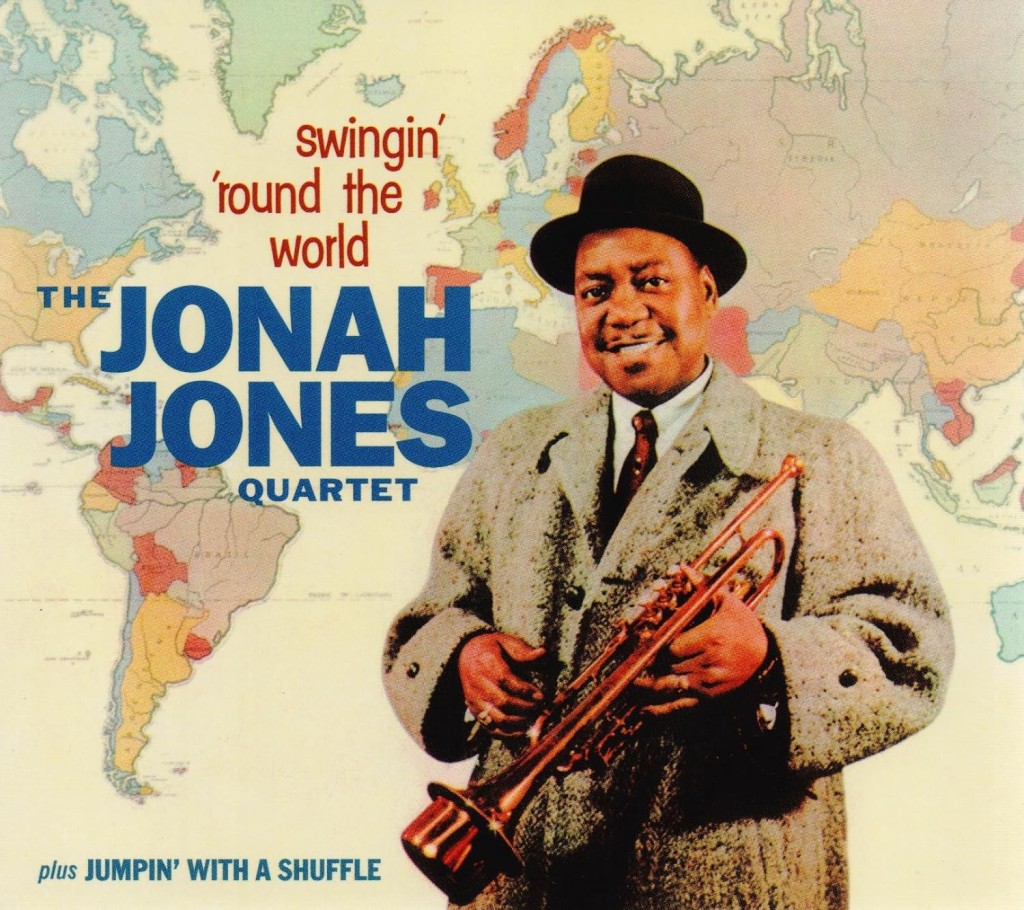Few swing era sidemen had as much commercial success in later years as Jonah Jones (1908-2000). A hot trumpeter with Stuff Smith’s combo on 52nd Street in the 1930s and Cab Calloway orchestra and small groups (1941-52), Jones was an exciting player who could create explosive solos as he showed on memorable and classic encounters with Sidney Bechet during 1953-54.
But as with most swing soloists by the mid-1950s, Jonah Jones was struggling a bit. Sometimes he played with Dixieland groups and at other times with society orchestras, making a living but not flourishing. That all changed in 1955 when he was booked into the Embers in New York with a quartet. He was encouraged to keep the music a little quiet by using a mute, and with the addition of a shuffle rhythm, Jones developed an accessible style that appealed to the upper class patrons. He recorded an album, Jonah Jones – At The Embers, for the Groove label in 1956 (later acquired by RCA Victor) and the result was a surprisingly popular recording. His melodic and concise versions of such songs as “Muskrat Ramble,” “Lullaby Of Rhythm,” “From This Moment On,” and particularly “It’s All Right With Me” appealed to a wide audience beyond jazz.
In 1957 Jonah Jones signed with the Capitol label and his mixture of Dixieland, swing standards, show tunes, and pop songs became so popular that he recorded 18 albums for the company in less than seven years. Jones’ versions of “On The Street Where You Live” and “Baubles, Bangles and Beads” were major hits and his stay at the Embers kept on being extended until it lasted nine years.
All of Jones’ Capitol recordings except for the last two (And Now In Person and Blowin’ Up A Storm) have been reissued by the Fresh Sound label, with two full albums included in each of their eight CDs. While it is not essential for jazz collectors to own every one of these sets, most are quite worthy and enjoyable.
 The first album, Muted Jazz, has Jones utilizing the same rhythm section as on At The Embers: pianist George Rhodes (later succeeded by Teddy Brannon), bassist John Brown, and drummer Harold Austin. “On The Street Where You Live” is joined by swinging versions of some Dixieland standards (“Rose Room,” “St. James Infirmary,” and “Royal Garden Blues”), a few swing tunes (“I Can’t Get Started” and “Undecided”), the recent Louis Armstrong hit “Mack The Knife,” and the theme from the movie “The Man With the Golden Arm.” Jones’ formula, which generally included muted trumpet solos (although in later years he played more open), short statements by the pianist, and an occasional Jones vocal, worked very well for years with most songs clocking in around three minutes despite the rise of the LP. Muted Jazz has been released by Fresh Sound on a CD that also includes the Hit Me Again album. The latter has such pieces as “Blueberry Hill,” “Moten Swing,” “The Surrey With The Fringe On Top,” and “High Hopes.” The rhythm section on the latter album, which has cuts from several sessions dating from 1957-60, sometimes includes Austin’s successor, a drummer named George “Pops” Foster who is no relation to the bassist.
The first album, Muted Jazz, has Jones utilizing the same rhythm section as on At The Embers: pianist George Rhodes (later succeeded by Teddy Brannon), bassist John Brown, and drummer Harold Austin. “On The Street Where You Live” is joined by swinging versions of some Dixieland standards (“Rose Room,” “St. James Infirmary,” and “Royal Garden Blues”), a few swing tunes (“I Can’t Get Started” and “Undecided”), the recent Louis Armstrong hit “Mack The Knife,” and the theme from the movie “The Man With the Golden Arm.” Jones’ formula, which generally included muted trumpet solos (although in later years he played more open), short statements by the pianist, and an occasional Jones vocal, worked very well for years with most songs clocking in around three minutes despite the rise of the LP. Muted Jazz has been released by Fresh Sound on a CD that also includes the Hit Me Again album. The latter has such pieces as “Blueberry Hill,” “Moten Swing,” “The Surrey With The Fringe On Top,” and “High Hopes.” The rhythm section on the latter album, which has cuts from several sessions dating from 1957-60, sometimes includes Austin’s successor, a drummer named George “Pops” Foster who is no relation to the bassist.
Swingin’ On Broadway (1958) is logically coupled with Broadway Swings Again (1961) and, as one would guess, all of the 24 selections were from Broadway shows. “Baubles, Bangles And Beads” is here plus songs that also caught on (“Just In Time,” “I Could Have Danced All Night,” “76 Trombones,” “Almost Like Being In Love,” and “Put On A Happy Face”) and a few that did not (“You’re So Right For Me,” “Just My Luck,” “Tall Hope,” and “Together Wherever We Go”). Jones and his rhythm section joyfully swing everything.
Swingin’ At The Cinema (1958) and I Dig Chicks (1959) has a dozen songs from movies dating from the 1930s to the late ‘50s (including “A Gal In Calico,” “Colonel Bogey March,” and “Lullaby Of Broadway”) plus “I Dig Chicks” and 11 songs named after women (such as “Mandy Make Up Your Mind,” “Tangerine,” and “Rosetta” but surprisingly not “Dinah”).
 Some of the album projects were a bit gimmicky in their themes. Swingin’ ‘Round The World (1959) has Jones and his quartet performing songs with titles having to do with locations or travel (including “South of the Border,” “A Foggy Day,” “Brazil,” “Chicago,” and “Manhattan”) but the music on that set is as solid as ever. The album is combined with one of Jones’ stronger records from the era, Jumpin’ With A Shuffle. Not having any particular theme, the latter has Jones digging into such numbers as “Dream,” “Lazy River,” “Misty,” and “My Monday Date.”
Some of the album projects were a bit gimmicky in their themes. Swingin’ ‘Round The World (1959) has Jones and his quartet performing songs with titles having to do with locations or travel (including “South of the Border,” “A Foggy Day,” “Brazil,” “Chicago,” and “Manhattan”) but the music on that set is as solid as ever. The album is combined with one of Jones’ stronger records from the era, Jumpin’ With A Shuffle. Not having any particular theme, the latter has Jones digging into such numbers as “Dream,” “Lazy River,” “Misty,” and “My Monday Date.”
Jumpin’ With Jonah (1958) is logically paired with Jonah Jumps Again (1959). Jones’ recordings were obviously made with potential radio airplay in mind for none of those performances exceed 3:01 in length. Still, the trumpeter gets his message across quickly, playing more Dixieland tunes than usual (including “Bill Bailey,” “That’s A Plenty,” and “Ballin’ The Jack”) along with “Night Train,” show tunes and some forgotten pop songs.
The remaining three CDs are mostly not on the same level. While A Touch Of Blue (1960) and Styled By Jonah Jones (1961) have their moments, the material is generally not worthy of the Jonah Jones treatment. The word “blue” (or “blues”) is in the song titles of each of the tunes on A Touch Of Blue while Styled has the trumpeter playing songs that mostly do not have much potential in a jazz setting including “The Poor People Of Paris,” “April In Portugal,” and “The Song From Moulin Rouge.” Clearly the formula was being stretched too far and Jones was running out of worthwhile material.
The Unsinkable Molly Brown (1960) was a hit Broadway show at the time but none of the 11 songs that Jones explores are worth reviving. That CD also includes the album Jazz Bonus (1962) which has the trumpeter trying something different than his usual quartet: a sextet with Dick Hyman on organ and both Bob Bain and Howard Roberts on guitars. Although the material is a bit better (despite the inclusion of “Lady Of Spain”), the results sound quite dated and uninspired. Organ was never Hyman’s best instrument!
The music on the final of the Fresh Sound discs is also erratic. The first half has Jones joined by a big band led by Glen Gray in 1962 playing Benny Carter arrangements of songs associated with other trumpeters. While it is fun hearing Jones interpret such numbers as “Two O’ Clock Jump,” “Hot Lips,” “After You’ve Gone,” and “West End Blues,” his renditions will not make one forget the superior original versions. And the second half of this CD, which reissues That Righteous Feelin’ (1962), is a misfire with Jones and the sextet with Hyman saddled with a gospel quartet that often sounds a bit corny on material that deserved better.
Jonah Jones returned to the quartet (with Andre Persiany on piano) for And Now In Person while adding three background trombonists to Blowin’ Up A Storm (both from 1963). But the Capitol label was changing rapidly with the rise of the Beatles and they felt that Jones’ formula had run its course. The trumpeter did not give up that easily, recording six similar albums for Decca during 1965-67 and two records of current pop tunes for Motown during 1968-69 before that period came to an end.
Of the Fresh Sound reissues, the most rewarding are Muted Jazz, Swinging’ At The Cinema/I Dig Chicks, and Jumpin’ With Jonah/Jonah Jumps Again. Against all odds, Jonah Jones became a household name a decade after the swing era ended and, for the rest of his life, he was able to work as often as he wanted.
Muted Jazz/Hit Me Again, Swingin’ On Broadway/Broadway Swings Again, Swingin’ At The Cinema/I Dig Chicks, Swingin’ ‘Round The World/Jumpin’ With A Shuffle, Jumpin’ With Jonah/Jonah Jumps Again, A Touch Of Blue/Styled By Jonah Jones, The Unsinkable Molly Brown/Jazz Bonus, and Jonah Jones-Glen Gray/That Righteous Feelin’
The albums are easiest found on Amazon searching by title.
Fresh Sound Records
www.freshsoundrecords.com
Since 1975 Scott Yanow has been a regular reviewer of albums in many jazz styles. He has written for many jazz and arts magazines, including JazzTimes, Jazziz, Down Beat, Cadence, CODA, and the Los Angeles Jazz Scene, and was the jazz editor for Record Review. He has written an in-depth biography on Dizzy Gillespie for AllMusic.com. He has authored 11 books on jazz, over 900 liner notes for CDs and over 20,000 reviews of jazz recordings.
Yanow was a contributor to and co-editor of the third edition of the All Music Guide to Jazz. He continues to write for Downbeat, Jazziz, the Los Angeles Jazz Scene, the Jazz Rag, the New York City Jazz Record and other publications.























